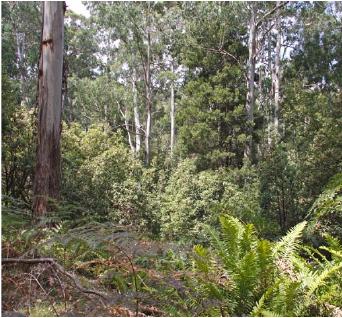Riparian Forest (EVC 18)
By Murray Ralph

Riparian Forest near Bullarto South. (photo by Tibor Hegedis)
Riparian forest is scattered throughout the forest as narrow strips along the banks and alluvial terraces of Riparian Forest near Bullarto South. (photo by Tibor Hegedis) (usually) perennial rivers and streams. Soils are fertile, well-drained and a constant supply of moisture supports a tall, multi-layered, species rich forest.
The overstorey is patchy in cover. It is dominated by Messmate (Eucalyptus obliqua) and Manna Gum (Eucalyptus viminalis), with Narrow-Leaf Peppermint (Eucalyptus radiata) also occurring. The understorey tree layer includes Blackwood (Acacia melanoxylon), Victorian Christmas Bush (Prostanthera lasianthos) and Hazel Pomaderris (Pomaderris aspera).
Shrubs include Prickly Currant-bush (Coprosma quadrifida), Hop Goodenia (Goodenia ovata), Prickly Moses (Acacia verticillata), Snowy Daisy Bush (Olearia lirata) and Austral Mulberry (Hedycarya angustifolia). The groundflora layer consists of a diverse range of ferns, grasses, rushes and herbs. Ferns include Fishbone Water-fern (Blechnum nudum) and Hard Water Fern (Blechnum watsii). Grasses and rushes include Common Tussock Grass (Poa labillardierei), Forest Wire Grass (Tetrarrhena juncea) and Spiny Headed Mat Rush (Lomandra longifolia).
Native herbs include Tasman Flax Lily (Dianella tasmanica), Bidgee Widgee (Acaena novae-zelandiae), Prickly Starwort (Stellaria pungens) Kidney Weed (Dicondra repens) and Cinquefoil Cranesbill (Geranium potentilloides).
Due to a history of past disturbance in many riparian areas and the moist, fertile soils, weed invasion by species such as Blackberry (Rubus fruiticosus) and Yorkshire Fog-grass (Holicus lanatus) may be high in some areas. In the Wombat Forest, the predominant threats to this EVC includes habitat fragmentation, weed invasion, fuel reduction burning, hydrological alteration, recreation and road construction/ maintenance.
